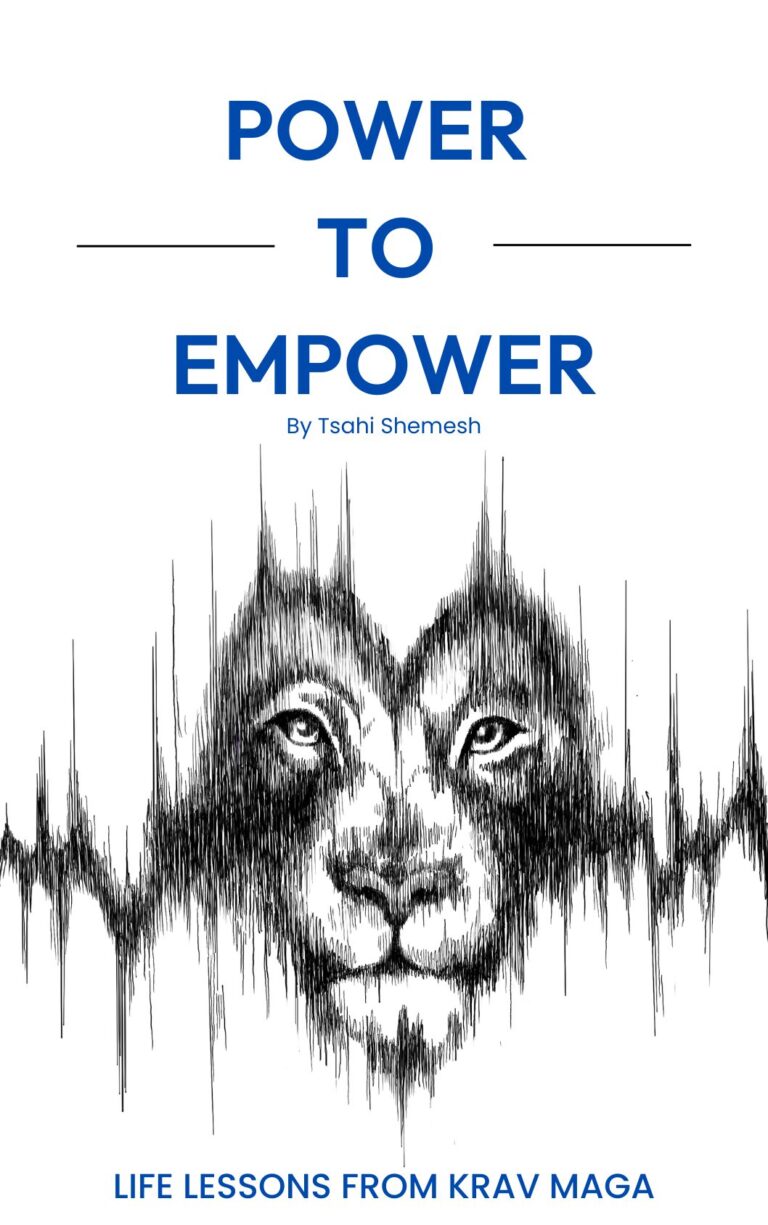Trauma and Trust:
Breaking the Cycle on the Mat
A recent encounter on the mat almost made me share a part of my book with my students. I hadn’t planned to reveal this chapter yet. But the timing was too clear to ignore. The message is too important to hold back any longer. It’s a raw, honest look at what happens when trauma, distrust, and fear collide inside a person who steps onto the training floor.
It’s about how motion and emotion disconnect and how the journey back to trust and presence begins. This is a sneak peek from my upcoming book, where self-defense becomes more than fighting; it becomes healing, reclaiming, and transformation.
A new student showed up to class that day. She was visibly frazzled, disconnected not just physically but somewhere deeper, disembodied. Her movements lacked flow and intention. When I guided her through the drills, she oscillated between two extremes that seemed impossible to reconcile.
At times, she was super aggressive, almost frantic. Her strikes were wild, uncoordinated like someone desperate to hurt, but not sure how or if she actually could. Yet beneath that storm, I sensed something else. She would have felt horrible if she actually hurt her partner. I am convinced she did not believe, deep down, that she could hurt anyone physically.
Then, without warning, she would switch. Suddenly sloppy, disconnected, hands dropping, movements half-finished, eyes darting away from contact. It was as if she was withdrawing from herself and the room. A shell closing down. Motion without meaning.
I stopped her and said simply: “Stay connected. Trust your partner.” She looked at me with a shy, embarrassed smile and said, “I don’t trust anyone. Not for any reason.”
Her partner – a calm, kind woman – reassured her quietly, “I won’t hit you. I won’t hurt you.” The student shook her head and insisted she did not trust her.
I have seen this before. It is not the first time on that mat. Over the years, I have helped many others shed that skin, this armor of distrust and fear, and find a better way of being. A stronger, clearer, happier version of themselves. I know the way there. I know the destination. She does not. Not yet.
She will not let me drive. Not yet. First, she has to build trust. She will test me. Many times. Little by little, the ice will melt. She will allow herself to reveal the sides she now only sees as vulnerable, weak, or dangerous.
This is the work. This is the fight beyond technique. Beyond strikes and footwork. The fight to reclaim connection with others and, most importantly, with herself.
So I decided to try something different. I asked her permission to hold her arm in a gentle but firm grip. I knew the moment I took it she was uncomfortable. I asked, “Are you comfortable with this?” She said no.
I asked, “Then why don’t you say something? Why try to pull away silently instead of telling me to stop?”
She looked down and whispered, “Because no one ever listens. What I say doesn’t make a difference.”
I pressed her, “Say it anyway. Say ‘stop.’ Let’s see what happens.”
With hesitation, she said it. I let go immediately.
That moment was a small victory. It was a crack in the wall she built around herself. She admitted she was always on super high alert, never relaxed, never letting her guard down. Again, I asked her to trust her partner, this woman who was there, ready and willing to help.
She shook her head firmly. “I can’t.”
Her partner smiled gently and said, “Hit me. I don’t mind. I won’t hit back.”
She was shy, reluctant, not wanting to strike, clearly doubting that the offer was genuine.
She told me, “All my therapists say the same thing. ‘You have to trust me if you want help.’ But I never do.”
I thought of her like someone stuck in a dark hole, scared and alone. When someone throws down a rope, she looks at it and sees a snake. So she refuses the help. Refuses to climb out. Refuses to breathe the air above.
This is the truth many carry. Trauma rewires the brain and body so deeply that safety becomes an impossible concept. Trust is a luxury some cannot afford to imagine. They stay frozen in a cycle of isolation, pain, and self-protection.
I will not talk to her about her issues. Words alone will not unlock what her body already knows but will not show freely. Instead, I will read her body language, her micro-movements, her tension and release, as she speaks it silently on the mat. I will offer guidance, not solutions. I will hand her the weights, but she will have to lift them, do the reps if she wants to get better.
Because real change is not handed over in words, it is earned in motion. It is claimed by those willing to show up, breathe through the discomfort, and keep moving forward even when trust feels like the hardest fight.
This is the crossroads where self-defense meets the human spirit, where movement becomes medicine, where the fight is not just about surviving an attack but reclaiming the simple, brutal truth that you deserve safety, connection, and peace.
The disconnect between motion and emotion is the root of so much pain. When the body moves but the heart and mind do not follow, trauma speaks loudest. Distrust becomes default. The fight or flight response becomes chronic hypervigilance. The soul feels trapped behind a wall built from past hurts and betrayals.
But this wall is not permanent. It can be dismantled with patience, repetition, and the steady building of trust. Not blind trust, but earned trust tested in small doses, proven by action. It is the same trust we practice on the mat. We train to connect with partners in a way that teaches safety under pressure. We learn to read and respond to nonverbal cues, to hold space and respect boundaries.
This student’s journey is not unique. It is the path I have witnessed again and again. The shedding of an old skin. The slow, painful rise toward presence and resilience. Toward becoming more than what fear and trauma once defined.
I do not promise a fast road. There is no quick fix. But I offer the map and the compass. I know the landmarks. The hard climbs and the rare, breathtaking views.
Her story is still being written. She will stumble. She will test. She will doubt. And she will, eventually, begin to breathe deeper, stand taller, and trust more.
Because beneath the fear, beneath the distrust, there is a part of her that longs to be free. To move fully and freely. To connect. To be safe. To be whole.
This is why we train. Not just to fight others, but to fight for ourselves. To reclaim what was lost. To learn that trust is not a weakness but a weapon. That motion leads to emotion. That courage is found in showing up, even when the world tells you to hide.
This moment, this student, this struggle, is a glimpse of what happens when self-defense becomes self-reclamation, when the mat becomes a place of healing as much as training.
And this is only the beginning.
Do something amazing.
Tsahi Shemesh
Founder & CEO
Krav Maga Experts
Suggested Articles:
-
Recovering From Trauma With Krav Maga: Rebuilding Trust in Yourself and Others
See how Krav Maga training helped survivors regain trust in themselves and the world around them, transforming fear into confidence. -
Understanding Freeze Response Trauma: Why Trust Feels Out of Reach
Discover how trauma locks you in survival mode and why rebuilding trust is key to breaking free from freeze responses. -
Catalyst to Change: Inspiration or Desperation?
Explore the hidden forces that drive real transformation. Learn why true change often comes not from comfort, but from the urgent need to survive and grow. This article challenges what you think about motivation and resilience.


First, im excited to hear about your book. I cannot wait to grab a copy. Second, this post resonates strongly with me although ive never really sought professional help with the trauma I experienced in life. In my culture, it is expected for us to “shake it off” or go for a run to “cure” us. That’s why over the years ive dealt with internal issues by running, working harder and simply keeping it all in. Did it help? Sure to some degree. But it kept coming back and until I finally told someone i trusted about all the turmoil ive been experiencing over the years did i manage to finally live better, breathe and move on. It’s not easy to trust anyone thats the truth. Most especially when we have been betrayed by those we hold dear. All the more it’s nearly impossible to even trust strangers. That’s part of the reason i train in self defense. I do not trust easily. I have a lingering fear from people have wronged me, those who have physically hurt me and those who almost successfully assaulted me. Some people train for reasons that include health/fitness, curiosity, fun, self defense. To me, training for krav and any self defense is rebuilding that trust not just towards others but also myself. I doubt myself a lot and i would like to fully reclaim that confidence i used to have before it was shattered to pieces from these untoward experiences i have had. I hope this student also realizes that gaining trust requires her participation too. No matter how wonderful everyone is around her, how well meaning, it will all be pointless if she doesnt open up and welcome the idea that there are people who wish the best for her. I dont know her but ive met such people, i was one of them before. I sincerely wish her well and i applaud for taking the step by simply going to the gym and interacting with other students and of course you. It’s not easy to be in that situation and not everyone will understand her plight but the fact you saw through it makes it remarkable and groundbreaking and I genuinely hope she too will see it one day that there are people who care and are worthy of her trust.
Thank you for sharing.
Much love and respect to you
Tsahi
Great article
Thank you, fighter